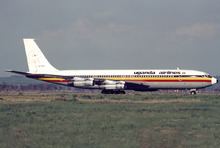Site Rome, Italy Crew 7 Survivors 19 Date 17 October 1988 Survivor 19 | Passengers 45 Fatalities 33 Number of deaths 33 Operator Uganda Airlines Location Rome | |
 | ||
Similar Austral Líneas Aéreas Fl, LOT Flight 703, Nürnberger Flugdienst Flight 108, China Southwest Airlines Fl, AVAir Flight 3378 | ||
Uganda Airlines Flight 775 was a Boeing 707-338C, registration 5X-UBC, that crashed while attempting to land at Roma-Fiumicino Airport in Rome, Italy on 17 October 1988. Thirty-three of the 52 occupants on board were killed.
Contents
Flight
Flight 775 took off from London-Gatwick bound for Entebbe with an intermediate stop in Rome. While descending into Rome, the flight crew was given clearance for an ILS approach to runway 16L. Due to poor visibility, a missed approach was carried out. A second approach was attempted to runway 25. This too had to be abandoned due to weather conditions. The crew requested radar vectoring to runway 34L. The aircraft was established on the localiser but descended through minimum safe altitude. The aircraft impacted with some trees, then crashed, broke into pieces, and burst into flames approximately 0.5 miles (0.80 km) short of the runway.
One of the 19 survivors was John Harigye, a businessman and former Ugandan ambassador to the Vatican.
Cause
The probable cause of the crash was determined to be "The crew's lack of adequate preparation in the procedure for a Non Precision Approach on runway 34L at Fiumicino Airport, especially in the matter of crew coordination and altitude callouts and their continued descent beyond MDA without having located the runway visual markings."
The following factors may have contributed to the cause of the accident:
Part of the Board of Inquiry as well as the representative of the Ugandan CA, disassociated themselves from the majority, during the phase of identifying the factors that may have contributed to causing the accident.
